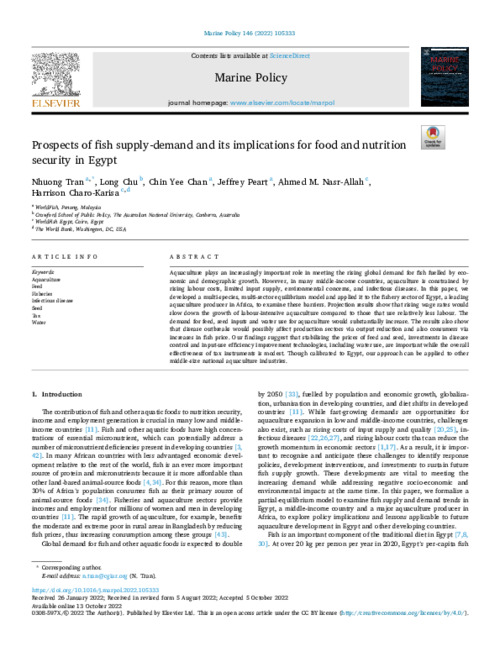Please use this identifier to cite or link to this item:
https://hdl.handle.net/20.500.12348/5466
Prospects of fish supply-demand and its implications for food and nutrition security in Egypt
| dc.creator | Tran, N. | en_US |
| dc.creator | Long Chu, H. | en_US |
| dc.creator | Chan, C. | en_US |
| dc.creator | Peart, J. | en_US |
| dc.creator | Nasr-Allah, Ahmed | en_US |
| dc.creator | Karisa, H.C. | en_US |
| dc.date.accessioned | 2023-02-20T10:02:32Z | |
| dc.date.available | 2023-02-20T10:02:32Z | |
| dc.date.issued | 2022 | en_US |
| dc.identifier.citation | Nhuong Tran, Hoang Long Chu, Chin Yee Chan, Jeffrey Peart, Ahmed Nasr-Allah, Harrison Karisa. (1/12/2022). Prospects of fish supply-demand and its implications for food and nutrition security in Egypt. Marine Policy, 146. | en_US |
| dc.identifier.issn | 0308-597X | en_US |
| dc.identifier.issn | 1872-9460 | en_US |
| dc.identifier.uri | https://hdl.handle.net/20.500.12348/5466 | |
| dc.description.abstract | Aquaculture plays an increasingly important role in meeting the rising global demand for fish fuelled by economic and demographic growth. However, in many middle-income countries, aquaculture is constrained by rising labour costs, limited input supply, environmental concerns, and infectious diseases. In this paper, we developed a multi-species, multi-sector equilibrium model and applied it to the fishery sector of Egypt, a leading aquaculture producer in Africa, to examine these barriers. Projection results show that rising wage rates would slow down the growth of labour-intensive aquaculture compared to those that use relatively less labour. The demand for feed, seed inputs and water use for aquaculture would substantially increase. The results also show that disease outbreaks would possibly affect production sectors via output reduction and also consumers via increases in fish price. Our findings suggest that stabilising the prices of feed and seed, investments in disease control and input-use efficiency improvement technologies, including water use, are important while the overall effectiveness of tax instruments is modest. Though calibrated to Egypt, our approach can be applied to other middle-size national aquaculture industries. | en_US |
| dc.format | en_US | |
| dc.language | en | en_US |
| dc.publisher | Elsevier (12 months) | en_US |
| dc.rights | CC-BY-4.0 | en_US |
| dc.source | Marine Policy;146,(2022) | en_US |
| dc.subject | feed | en_US |
| dc.subject | infectious disease | en_US |
| dc.subject | tax | en_US |
| dc.title | Prospects of fish supply-demand and its implications for food and nutrition security in Egypt | en_US |
| dc.type | Journal Article | en_US |
| cg.contributor.crp | Policies, Institutions, and Markets | en_US |
| cg.contributor.crp | Fish | en_US |
| cg.contributor.funder | International Food Policy Research Institute | en_US |
| cg.contributor.project | W1/W2 - PIM Phase 2 | en_US |
| cg.coverage.country | Egypt | en_US |
| cg.coverage.region | Northern Africa | en_US |
| cg.subject.agrovoc | aquaculture | en_US |
| cg.subject.agrovoc | fisheries | en_US |
| cg.subject.agrovoc | seed | en_US |
| cg.subject.agrovoc | water | en_US |
| cg.subject.agrovoc | Fish | en_US |
| cg.contributor.affiliation | The World Bank | en_US |
| cg.contributor.affiliation | WorldFish | en_US |
| cg.contributor.affiliation | Australian National University | en_US |
| cg.identifier.status | Open access | en_US |
| cg.identifier.ISIindexed | ISI indexed | en_US |
| cg.contribution.worldfishauthor | Tran, N. | en_US |
| cg.contribution.worldfishauthor | Chan, C. | en_US |
| cg.contribution.worldfishauthor | Peart, J. | en_US |
| cg.contribution.worldfishauthor | Nasr-Allah, Ahmed | en_US |
| cg.contribution.worldfishauthor | Karisa, H.C. | en_US |
| cg.description.theme | Value chains and nutrition | en_US |
| dc.identifier.doi | https://dx.doi.org/10.1016/j.marpol.2022.105333 | en_US |
| cg.creator.id | Nhuong Tran: 0000-0002-1813-4571 | en_US |
| cg.creator.id | Chin Yee Chan: 0000-0001-8615-2678 | en_US |
| cg.creator.id | Ahmed Mohamed Nasr-Allah: 0000-0001-6299-8556 | en_US |
| cg.creator.id | Harrison Charo Karisa: 0000-0001-5323-794X | en_US |
